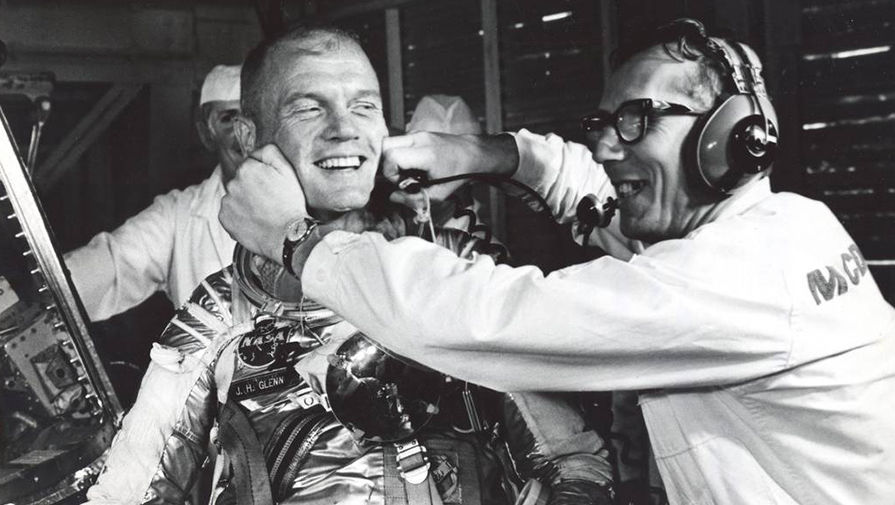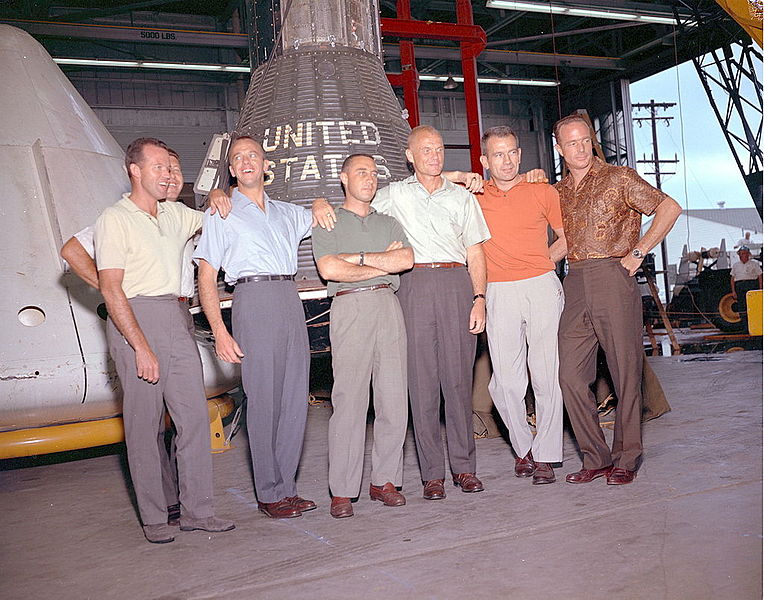John Glenn died, the first American to make an orbital flight.

Source: NASA
Anyone dies sooner or later. This is a truth that has never been refuted in the entire history of mankind. Unfortunately, astronauts also die, and at the age of 95 John Glenn died . He was the first American to fly around the Earth in a spacecraft. In his life there was enough adventure, and one of the last happened already in old age - he flew into space when he was 77 years old.
Thus, he is the first American to make an orbital flight in a spacecraft. He also became the oldest astronaut who visited space, the first man, between orbital flights of which 36 years passed and the only astronaut who lived to 2016 from the first set of the USA.
John Glenn was born on July 18, 1921 in Cambridge (USA). He loved flying early. At the age of 8 years, the future astronaut made his first biplane flight. Two years before, Charles Lindberg crossed the Atlantic. Probably the very first flight with his father and predetermined the future of the boy.
')
Like most Americans, he graduated from high school and college with a bachelor’s degree. After that, he decided to join the army, joining the Marine Corps. He served as a pilot, fighting with Japan. During the war, Glenn made 59 sorties in the Marshall Islands. After he had to make another 90 sorties during the Korean War.
After the war, the brave pilot decided to continue his pilot's career and entered the test pilot school. In June 1957, he managed to set a record: Glenn made the world's first transcontinental flight on a supersonic jet fighter. It was a Vought F-8 Crusader. From Los Angeles to New York, the future astronaut flew in 3 hours and 23 minutes. Then he had the rank of lieutenant colonel. In total, he managed to fly about 9000 hours, and about 3000 fell on jet flights.
"The first seven"
A few years later, the United States took part in the space race, competing with the USSR. The first work on the US manned flight program began at the Langley Research Center, Hampton, Virginia. Here they began to train astronauts, as well as the Americans began to develop the spacecraft "Mercury", developing, among other things, control and flight control systems and landings.
In 1958, the NASA agency was formed. In the same year, in November, the Americans gave the name of their manned space flight program: “Mercury”. As the program of manned flights was developed, the Americans needed to quickly recruit an astronaut team for its implementation. Preparation began immediately after the announcement of the program itself. The leadership planned to split the astronaut selection program into several stages. At the first stage, it was planned to select about 150 candidates. Of these, during the second stage, 36 people were to be selected. At the third stage, it was necessary to select 12 people, of whom, after nine months of training, the Americans decided to choose the final composition of the astronaut team of six people.
There were many conditions for participation in the program. Candidates for astronauts should have a good education and have a bachelor's degree. The age of the project participants was to be from 25 to 40 years. Potential astronauts should have excellent health. In addition, candidates should have had three years of experience in mathematics, physics, biology, psychology, or research experience in technical areas. If there was no such experience, the candidate could have had a three-year experience of flying on airplanes, balloons, or serving on a submarine as a commander, pilot, navigator, communications specialist, or equivalent. As for the flight experience, the candidate should have had at least 1500 “flown” hours.
Candidates who fulfilled all the requirements for a doctoral degree in a certain scientific field or in engineering also approached. A person who has semi-annual clinical or research experience could also become an astronaut. It was desirable that the candidate could jump with a parachute, engage in underwater sports or be a professional athlete.
Initially, 110 people were selected, among whom were 5 officers of the Marine Corps, 47 pilots of naval aviation and 58 pilots of the Air Force. After a detailed consideration of candidates, the special commission decided to select 35 people, who were invited to Washington on February 2, 1959. Most of the selection participants made the final decision to participate in the program. At the same time, the project management decided that there was no sense in choosing 12 people; instead, the number of candidates was reduced to six. 32 candidates were examined at a specialized clinic, after which 31 people remained in the team of applicants for the title of astronaut. After they were surveyed at the Wright Research Center, the number of applicants dropped to 18. There were many worthy ones, so it was difficult for the commission to make a choice. We decided to choose not 6 people, but 7.
The structure of the " first seven " were such experts:
- Gordon Cooper (L. Gordon Cooper Jr.) - Captain of the Air Force;
- Virgil Grissom (Virgil I. “Gus” Grissom) - Captain of the Air Force;
- Donald K. “Deke” Slayton - Captain of the Air Force;
- Scott Carpenter (M. Scott Carpenter) - Lieutenant of Naval Aviation;
- Alan Shepard (Alan B. Shepard Jr.) - Senior Lieutenant of Naval Aviation;
- Walter Shirra (Walter M. Schirra Jr.) - Senior Lieutenant of Naval Aviation;
- John Glenn (John H. Glenn Jr.) - Lieutenant Colonel of Naval Aviation.
The oldest member of the team was Johnn Glenn, he was then 37 years old. The youngest member of the team was 32 years old.

That very first seven. From left to right: Gordon Cooper, Walter Schirra, Alan Shepard, Virgil Grissom, John Glenn, Donald Slayton, Scott Carpenter (source: NASA)
After the formation of the G-7, its members began training at the Langley Research Center. These trainings included a large number of elements: theoretical classes in astronomy, celestial mechanics and navigation, exercise on simulators, scuba diving, and much more. Training was conducted in such a way that each team member gained experience in a particular technical discipline. So, Cooper and Slayton were engaged in launch vehicles and launch equipment. Carpenter was an expert in communications and navigation systems, and Glenn, after completing his training sessions, became an expert in equipping the cabin. In addition, Griss specialized in flight control systems, Schirr in life support systems and space suits, and Shepard specialized in tracking and rescue systems.
John Glenn was appointed understudy for Alan Shepard. The last on May 5, 1961, made a suborbital space flight. Glenn was also a backup for Virgil Grissom, who made a similar flight on July 21, 1961.
Glenn became the third person in the world (after Yuri Gagarin and German Titov), who made an orbital space flight. On February 20, 1962, he flew around the Earth three times on the ship Mercury-Atlas-6 . The duration of this flight was 4 hours and 55 minutes. He commented on the state of weightlessness as follows: "Weightlessness, and I feel good." Upon returning to Earth, John Glenn became the national hero of the United States. Based on the implementation of the project "Mercury" was filmed the film "Guys what is necessary", where Glenna played Ed Harris.
Later it became known that during the flight in February 1962, the astronaut conveyed to the dispatcher that his spacecraft was "pursued by some kind of fiery sparks and flashes." This is not about "green men", but about ice crystals that arose during the work of hydrogen engines. These crystals accompanied the ship , reflecting the sunlight.
Glenn was not satisfied with the role of the “living icon” in NASA. He wanted to work for the good of society. Therefore, in January 1964 he left astronauts in order to declare his intention to run for the Senate the very next day. Then he failed to become a senator, but in the 70s of the last century Glenn repeated the attempt, and this time quite successfully. He managed to become a senator from Ohio in 1974. He remained a senator until 1999. In 2011, Glenn was awarded the Congressional Gold Medal (this is one of two top US awards). And in 2012 he received the second highest award, the Presidential Medal of Freedom. When he was a senator, the ex-member of the “first seven” lobbied for state support of the space program, education and popularization of science.
Glenn made his second flight much later, 36 years after the first. He flew into space on Discovery as a payload specialist. It happened on October 29, 1998. He returned to Earth on November 7 of the same year. Then he turned 77 years old, and he became the oldest person who flew into space. John Glenn for a long time sought permission from NASA to fly into space a second time. He justified his request with the intention to study the effect of weightlessness and space flight on the organism of an elderly person. Well, it was a purely scientific experiment, and it was completely successful - take-off, stay in orbit and landing went off without a hitch.
“My friend American astronaut John Glenn flew for the second time at 77 years old. This was a special case. The public turned to then-President Clinton, and he gave the go-ahead. The flight of Glenn was a sign of state respect for the honored person, ”cosmonaut Aleksey Leonov, the first person to be in outer space, said earlier.

Source: AP Photo / Jay LaPrete
“John has overcome barriers all his life, defending our freedom as a pilot in the Second World War and the Korean War, making a transcontinental supersonic flight, becoming the oldest person who, at the age of 77, touched the stars. John had all the necessary qualities to inspire generations of scientists, engineers and astronauts who still have to send us to Mars and beyond its orbit not just to visit, but also to stay, ”US President Barack Obama appreciated the merits of“ one of the seven ” .
Glenn died at the age of 95 years. Earlier it was reported that he was in the department for the treatment of cancer at Ohio State University. It is not yet clear whether the astronaut was diagnosed with cancer. He was taken to the hospital after an unexpected deterioration in his health.

Buzz Aldrin once said about Glenn that he is "a pioneer of space and an icon for the whole world." And indeed it is.
Source: https://habr.com/ru/post/399949/
All Articles